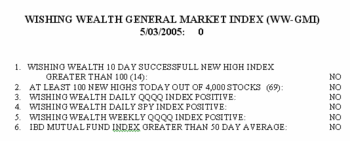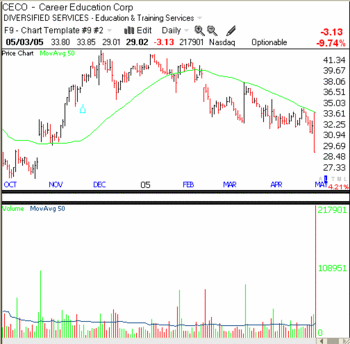I think you do your listeners a disservice.
Mutual funds must stay invested, individuals do not. About 70% of stocks go with the market indexes. When the indexes are declining as they have been for weeks, it is your duty to tell people not to fight the trend. Get out of the way, safely in cash, or go short. Why try to find the few exceptions that can fight the trend. Go with the odds, as Livermore, Baruch and O’Neil did.
There are enough pundits urging people to buy–you are smarter than that. Or will you lose your audience if you tell people to stay in cash?
Sent to Jim Cramer, MadMoney show, April 15, 2005
Today, Cramer told his audience to “AVOID” 80% of stocks in this economic environment. He then went on to describe the stocks they could buy and proceeded to the lightning round of rapid buy/sell/hold advice. Why does a talented hedge fund manager who clearly sold short and traded options, never advise his listeners to do what he did? Why is he always looking for buys, when he thinks 80% of stocks are declining? Does he think the rest of us cannot be trained to use these techniques which he, himself, used, to profit from declines? Buy in a declining market? This is insane–now I know why they named the show MadMoney.
One reader sent me a quote from the professor, Peter Navarro, www.peternavarro.com, suggesting why CNBC has a penchant for bullishness:
“Ah, those bullish fumes that so very often make the CNBC bubbleheads such wonderful contrarian indicators. Oil prices off the charts, interest rates moving inexorably up, inflation pressures building. No worries. Be happy at CNBC- cause bearish rhetoric makes for bad ratings- and besides, it’s not their money they are losing for you.” Navarro’s Broad Outlook for the Market: Smile for the CNBC Camera, 4/4/2005.
Now, I thought I was irreverent! In researching this quote, I looked over Peter Navarro’s free weekly report and was very impressed. You might want to check it out at www.peternavarro.com, click on weekly column. It is nice to see someone else who is not afraid to talk about shorting stocks or to be in cash! Do you think that if Cramer advised listeners to short some stocks, it would destroy his ratings? I think it sure would help his credibility. This weekend I will begin to discuss how we little people can take advantage of shorting like the big guys–unless the market should undergo a sudden metamorphasis.
Speaking of the market, the WW-GMI for today remains at zero. There were only 14 stocks that hit a new high 10 days ago and closed higher today than they closed 10 days ago (when the stock made the new high). Thus, few of these new highs were successful. The analogous number for new lows 10 days ago is 43. In addition, there were more new 52 week lows today than highs (79 vs. 69 in our universe of 4,000 stocks). However, the SPY is very close to the area where my daily index will turn positive. If it closes above 117 for 2 days , the index will turn positive and suggest to me that a tradeable rally has begun. The QQQQ is still far away from signaling a turn.
There were only 14 stocks that hit a new high 10 days ago and closed higher today than they closed 10 days ago (when the stock made the new high). Thus, few of these new highs were successful. The analogous number for new lows 10 days ago is 43. In addition, there were more new 52 week lows today than highs (79 vs. 69 in our universe of 4,000 stocks). However, the SPY is very close to the area where my daily index will turn positive. If it closes above 117 for 2 days , the index will turn positive and suggest to me that a tradeable rally has begun. The QQQQ is still far away from signaling a turn.
———————————————————————————
I hate to say I told you so, but remember I said Monday night that COCO, CECO and APOL looked sick? They declined , -4.26%, -9.74% and -1.31%, respectively, today. I guess it was a lucky call. I sure didn’t know any news about CECO; it was all in the chart.  I identified the downtrend in the weekly chart but have printed the daily chart here to show you the tremendous decline it had today. Click on the chart to enlarge it. Notice how the 50 day moving average (green line) had topped out in February and that the stock met resistance at this average. Note the large gap down in February on high volume- a sign of massive institutional selling. (Gaps in price are worthwhile tracking.) The stock rose back to the 50 day and closed the gap and then began its decline. The selling was all visible in the chart, and I never knew anything about a class action lawsuit against the company. Nicolas Darvas would say if he shorted the stock, that he had become a silent partner with the sellers by jumping on board after them.
I identified the downtrend in the weekly chart but have printed the daily chart here to show you the tremendous decline it had today. Click on the chart to enlarge it. Notice how the 50 day moving average (green line) had topped out in February and that the stock met resistance at this average. Note the large gap down in February on high volume- a sign of massive institutional selling. (Gaps in price are worthwhile tracking.) The stock rose back to the 50 day and closed the gap and then began its decline. The selling was all visible in the chart, and I never knew anything about a class action lawsuit against the company. Nicolas Darvas would say if he shorted the stock, that he had become a silent partner with the sellers by jumping on board after them.
The housing stocks with the ugly charts tended to decline today too. I think this weekend I will post a table tracking the performance of the ugly charts after I commented on them. Maybe I should compute a pulchritude index for stocks. Tomorrow will be a pivotal day for the SPY. Will it close above 117?